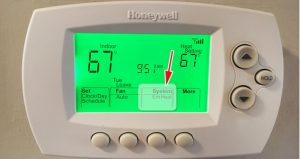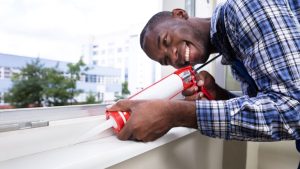The Difference Between Auxiliary Heat and Emergency Heat in HVAC
As the weather cools down, homeowners rely on their HVAC systems to keep their homes warm and comfortable. If you have a heat pump system, you may have noticed terms like “auxiliary heat” and “emergency heat” on your thermostat. But what do these terms mean, and how do they differ from each other? Understanding the distinction between auxiliary heat and emergency heat can help you better manage your HVAC system and ensure it’s working efficiently when you need it most.
At Summers Comfort Heating & Air, we’re here to clarify these HVAC terms and provide insights into when and how they operate.
What is Auxiliary Heat?
Auxiliary heat (often abbreviated as “AUX” on thermostats) is a secondary heating source that works in conjunction with your heat pump. In most cases, it kicks in automatically when your heat pump alone cannot efficiently heat your home. This usually happens when the outdoor temperature drops too low, typically below 35°F to 40°F, making it harder for the heat pump to extract enough warmth from the outside air.
How Auxiliary Heat Works:
Heat pumps transfer heat from the outside air into your home to maintain a comfortable temperature. However, in colder weather, the heat pump’s ability to extract heat diminishes. That’s when the auxiliary heat kicks in to provide additional warmth. In many cases, auxiliary heat comes from electric resistance heaters or a gas furnace that supports the heat pump during these times.
Auxiliary heat is part of the normal operation of your heat pump system and is designed to assist the primary heating method, not replace it. It’s triggered automatically when your thermostat detects that your home isn’t reaching the desired temperature quickly enough. Once the outdoor temperature rises or the home reaches the set temperature, the auxiliary heat turns off, and the heat pump continues to operate on its own.
When Auxiliary Heat Kicks In:
- During Extremely Cold Weather: As the temperature outside drops, your heat pump becomes less efficient, and auxiliary heat activates to compensate.
- When the Thermostat is Set Higher: If you suddenly increase the temperature on your thermostat by several degrees, auxiliary heat may activate to help the system reach the new temperature quickly.
- Defrost Cycle: Sometimes, when the outdoor unit enters a defrost cycle to remove ice buildup, the heat pump will temporarily switch to auxiliary heat to maintain indoor comfort.
What is Emergency Heat?
Emergency heat is another backup heating option, but unlike auxiliary heat, it is used in more critical situations. The main difference is that emergency heat is manually activated by the homeowner when there is a problem with the heat pump itself. It bypasses the heat pump entirely and relies solely on the secondary heating system, usually electric resistance heaters or a gas furnace, to provide warmth.
How Emergency Heat Works:
Emergency heat is designed to be used when your heat pump fails or is not functioning correctly. This mode allows you to continue heating your home until the heat pump can be repaired. Unlike auxiliary heat, which works alongside the heat pump, emergency heat disables the heat pump altogether. When you switch to emergency heat, your HVAC system will use only the secondary heating source, which can be less efficient and more expensive to operate.
Emergency heat is intended for temporary use only, as running your system in this mode can lead to higher energy bills due to the less efficient nature of electric resistance heating.
When to Use Emergency Heat:
- Heat Pump Failure: If your heat pump stops working or malfunctions, switch to emergency heat to keep your home warm until repairs are made.
- Freezing Weather During Heat Pump Failure: If outdoor temperatures drop significantly and your heat pump isn’t working, you may need to manually switch to emergency heat to ensure your home stays warm.
Key Differences Between Auxiliary Heat and Emergency Heat
- Automatic vs. Manual Activation:
- Auxiliary Heat: This activates automatically when needed to assist the heat pump during cold weather or during the defrost cycle.
- Emergency Heat: This is manually switched on by the homeowner when the heat pump is not working.
- Primary Purpose:
- Auxiliary Heat: Designed to support the heat pump during times when it struggles to extract enough heat from the air.
- Emergency Heat: Used as a backup when the heat pump fails and needs to be bypassed entirely.
- Efficiency:
- Auxiliary Heat: While it’s less efficient than a heat pump alone, it’s still part of the system’s overall design and operates alongside the heat pump when necessary.
- Emergency Heat: Typically less energy-efficient, as it relies solely on electric or gas backup heat without the aid of the heat pump.
- Cost:
- Auxiliary Heat: While it increases energy usage, it’s not as costly as running emergency heat for an extended period.
- Emergency Heat: Because it uses less efficient backup heating, emergency heat can lead to higher energy bills if used for long periods.
Which Should You Use?
In most cases, your HVAC system will automatically switch to auxiliary heat when necessary, and you won’t need to do anything. Auxiliary heat is a normal part of the system’s operation, especially during cold weather.
Emergency heat, on the other hand, is meant for emergencies. If your heat pump stops working, you can switch to emergency heat to ensure your home stays warm. However, it’s essential to call a professional HVAC technician as soon as possible to repair the heat pump, as running emergency heat for long periods can result in high energy bills.
Stay Warm with Summers Comfort Heating & Air
Understanding the difference between auxiliary heat and emergency heat can help you better manage your HVAC system during the winter months. At Summers Comfort Heating & Air, we’re here to help with all your heating needs in Denham Springs. Whether you need repairs, maintenance, or a new installation, our team is ready to ensure your home stays comfortable all year round.
If you have questions about auxiliary heat, emergency heat, or any other HVAC issues, don’t hesitate to contact us today!
Your trusted HVAC experts in Denham Springs, keeping your home comfortable no matter the weather.




